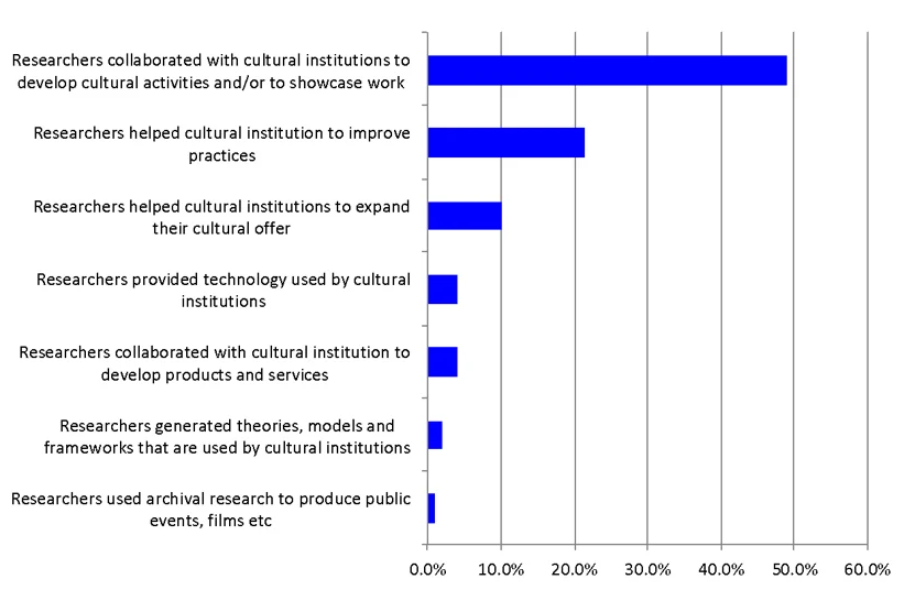By Dr Federica Rossi, Associate Professor, Universita’ di Modena e Reggio Emilia; Deputy Director, CIMR ; Co-Investigator, Evidence and Impacts – NCACE
The importance of impact arising from, and having effects on, artistic and cultural production
While it is broadly acknowledged that academic research should generate real-world impact, the discourse often focuses on impact arising from academic knowledge feeding into technological and business innovation; much less so on the impacts that involve, either as means or outcomes, artistic and cultural activities. Yet, universities’ artistic and cultural production represents a huge part of their output, and a significant amount of the impact generated by academic research includes an artistic and cultural component. To shed some light into how universities generate what we term ‘arts and culture-related impact’ we analysed the impact case studies submitted by universities to the Research Excellence Framework 2021.
The Research Excellence Framework (REF) is a major national assessment that is undertaken by UK based universities every seven years. It is a system for measuring the quality of academic research, based on the evaluation of several elements: the quality of the university’s publications, the quality of its research environment and, since 2014, the impact that the university’s research has on ‘the economy, society, culture, public policy or services, health, the environment or quality of life, beyond academia’ (REF, 2011, p. 26). The REF impact case studies, which are available to download freely from the REF’s website, are a very valuable source for analysing how academic research in the UK generates impact. To identify, out of the 6,361 submitted case studies, those with ‘arts and culture-related impact’, we selected all those where the words ‘arts’ and ‘culture’ were mentioned, irrespective of which Units of Assessment they were submitted to. This approach has the advantage to identify cases submitted across all disciplines, with the caveat that it might overlook some cases which have had an impact occurring through, or on, arts and culture, but which did not use the words ‘art’ or ‘ culture’ in their impact descriptions.
Findings from the analysis of cases with ‘arts and culture-related impact’
Having identified 1,075 cases submitted by 140 different institutions (equivalent to 17% of all impact cases), with ‘arts and culture-related impact’ we analysed their main features, and identified several specificities.
- The arts and humanities had the greatest share of submitted cases with arts and culture-related impact (archaeology as well had a large share of such cases); however, some STEM fields like Physics, Geography and Computer Science exhibited a remarkably high share of cases with arts and culture-related impact. As could be expected, the top ten institutions with the greatest shares of cases with arts and culture-related impact were all specialist arts institutions.
- There is some evidence that units that submitted a greater share of impact cases with arts and culture-related impact had a lower share of impact cases rated 4*. The negative correlation however is weak overall, and differs across Units of Assessment.
- Cases with arts and culture related impact tended to have less formal partners, across the board (though in general those submitted to STEM fields had more formal partners than those submitted to the social sciences and humanities).
- Cases with arts and culture related impact were, however, more likely to receive external funding and to have a larger number of funders than the average. This pattern was particularly pronounced for cases with arts and culture related impact submitted in STEM fields.
- Cases with arts and culture related impact were less likely to be a continuation of cases submitted to REF 2014. This finding raises the question as to whether arts and culture-related impact is more short-lived, or whether it is more project-specific, and it is more difficult to repurpose the research outcomes to generate impact beyond those obtained initially in a specific context or with specific stakeholders – something that appears to be more achievable in the STEM subjects. It is also possible that there are many enduring partnerships between Universities and the arts, but these may not necessarily result in impacts that make it into the REF.
- Cultural institutions played an important role in supporting, enabling and benefitting from the production of research impact. Of the 1,075 impact cases with arts and culture-related impact, 202 indicated one or more cultural institutions as partners: 130 cases had one cultural institution as partner, 49 had two cultural institutions as partners, 23 had more than two. Overall, 289 cultural institutions were indicated as partners.
- We identified seven different modes of engagement between researchers/Universities as shown in the following figure, which reports, out of 202 cases involving cultural institutions, the share of cases that displayed each mode of engagement.

Recommendations for policy and practice
These findings allow us to offer some general recommendations for policy and practice.
First, policymakers should gain better knowledge about emerging weaknesses of cases with arts and culture-related impact: policy should understand better whether it is true that cases with arts and culture-related impact tend to score less highly in the REF, and if so what are the reasons for this. It would also be important to understand why cases with arts and culture-related impact are less likely to be a continuation of cases submitted to REF 2014. Deep dives into specific cases and qualitative research (e.g. interviews with individuals and organisations involved in submitting such cases) could shed light on these issues.
Second, universities should learn from good practices emerging from cases with arts and culture related impact: since cases with arts and culture related impact are more likely to receive external funding and to have a larger number of funders than the population average, they can be studied in order to derive lessons for individuals and organisations in other subject areas relating to how to successfully apply for funding and how to put together successful consortia applying to multiple funding sources.
Third, universities should learn how to collaborate with cultural institutions: The identification of eight different modes of engagement of cultural institutions can help universities to gain a good overview of what are the possible ways to engage with cultural institutions, to identify which mode of engagement is more suitable to their needs, and to decide how to set up collaborations accordingly.
See: “Chapter 1, Arts and culture-related impact in the 2021 REF impact case studies: an analysis of the evidence” of the full report, REF 2021: Research Impact and the Arts and Culture Sectors
This post was originally published on The National Centre for Academic and Cultural Exchange (NCACE)’s website on 09/01/2024: https://ncace.ac.uk/2024/01/09/how-does-academic-research-generate-impact-through-or-on-artistic-and-cultural-activities-an-analysis-of-the-2021-ref-impact-case-studies/

